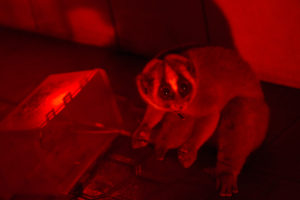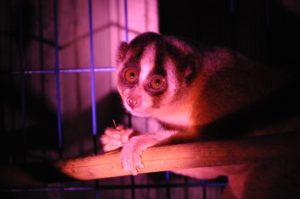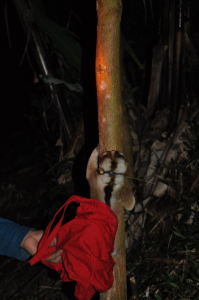I have been at the Little Fireface Project for over 3 months now and I have enjoyed it immensely. Everything from observations to our team building trips at the beach or hot springs have been incredibly memorable and will stay with me for a lifetime.
I have been part of quite a few releases in these last few months because of the number of slow lorises that have been brought to us by the locals. There have been six lorises in total that have been brought to us for either safety or health reasons and each one has been very different from the last. These lorises were given a room in the house that was fitted specially with flexible supports and branches that they would use in the wild. They then had fresh flowers, insects and gum brought to them every day to provide them with a healthy diet and to allow them to exercise whilst they were in our care. When a loris is being released, the habitat that is chosen for the release is exceptionally important. Each release undergoes a great deal of pre-release preparation; this includes meticulous assessment of the area to check for relevant tree species, the number of lorises and people, and the connectivity of the area. One of these lorises, Xena, sticks in my memory quite vividly. She was very lively and managed to escape from her cage multiple times.

She had been found in the centre of a nearby town, on a roof, and so we believe that she was being kept as a pet and escaped, since she proved she was so good at it. After a few days she was released and I was lucky enough to be part of the post-release monitoring. I got to see the unusual and interesting behaviours that differ from lorises we usually observe; she travelled a lot during this observation and we ended up walking down one mountain and up another one in a 6-hour period. In this time, she was travelling through other lorises’ home ranges, which would have influenced her decisions to travel and in which direction. These observations continued over a few days after her release, of which I was part of most of the days. This post-release monitoring was incredibly important because it allowed us to see if the lorises were remaining healthy and safe.

Genda was another interesting case of a loris brought into our care. Much more docile than Xena, he was the first to experience the adapted wet-room that was fitted with supports and branches. He was a very calm loris and when being fed just watched the insects being placed in the room, and then slowly made his way towards them. He stayed a few days before being released and, deciding that the area was not to his liking, travelled many kilometres to a new area near another village. We continued to watch his progress and, finding that he was content in his new environment, we cut his collar.

The area he had chosen was not an area we could continue to observe in during the night and so it was better to cut his collar and send him on his way, knowing that he would be absolutely fine as a wild loris. Losing Genda was sad for me because I enjoyed going to find his sleeping site during the day, seeing a very different area to where we usually do observations. It was very open with a beautiful view of the mountain and a wide river that added to the scenery. Those walks were always stunning and very enjoyable. Releases are very rare here so it has been a privilege to be a part of so many during my stay at the Little Fireface Project.
Obviously having lorises that need our help is not a good thing, but the fact that the locals are bringing more to us means that they are more aware of our presence and care more about the welfare of the lorises. This in itself is promising and highlights the positive impact that the project is having on the surrounding area.
- Natasha Kabała
- Volunteer
